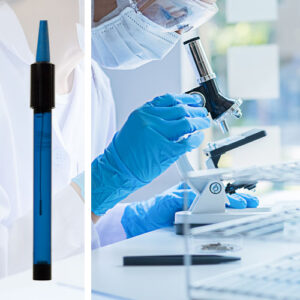An ion-selective electrode can be considered a battery when immersed in a solution. It will develop a voltage relating to the dissolved ion concentration of a particular salt in solution. How do you convert this voltage into a concentration value? An electronic circuit within a properly designed voltmeter receives the voltage from the ISE electrode and converts it into a ppm value for display. To be more specific, the circuit compares the voltage from the specific ion electrode to the voltage produced from the reference electrode. It displays the difference on the ion concentration meter as a ppm value. The design of each electrode component is critical to the functioning of the circuit and should be discussed separately.
ISE electrodes are available in many shapes and lengths to fit various applications. Normally, the sensing electrode has a flat membrane embedded with a specific ion-sensitive material. The membrane is in contact with an internal electrode conductor element (Ag-AgCl) connected to the electrode lead, which is connected to the pH or concentration meter. The voltage, which will develop for the ISE electrode, is a function of the ion-sensitive membrane. The electrode response may be described as the voltage developed between the inside and the outside of the ion-sensitive membrane. The ion-sensitive membrane composition will determine the electrode’s response time and sensitivity to other ions.
As noted, the ISE membrane is a half-cell and needs a companion reference electrode half-cell to function. A reference electrode consists of a nonconductive body and a liquid junction maintaining contact between the internal electrolyte and external fluid sample being measured. An internal electrode conductor element (Ag-AgCl) immersed in the internal electrolyte is connected to the electrode lead, which is connected to the pH meter. A good reference electrode will produce a very stable output voltage. For example, one of the most common reference electrode systems is based on silver/silver chloride/potassium chloride. This reference system consists of a silver wire electrolytically coated with silver chloride or dipped in a paste of silver chloride. This metal/metal salt combination is dipped in a concentrated potassium chloride solution saturated with silver chloride. Contact between the saturated KCl and the measured sample solution, the liquid junction, is made through a porous ceramic pin. The voltage which is produced by this system is constant and unaffected by the pH of the sample. The internal filling solution should not contain KCl if it interferes with the sample, if there is a chance that the liquid junction will clog due to precipitation, or if it is immiscible with the sample. The use of a double junction electrode with a second internal junction containing no KCl or a modified internal filling solution can be used. The double junction configuration also isolates the silver ion from direct contact with the sample fluid, decreasing the probability of sample contamination. An electrode using potassium nitrate as an outer reference filling solution is one example. Many other outer fill solutions are known.
Combination ISEs are advantageous in that they are often less expensive than a pair of individual half-cell electrodes, and the more compact geometry allows use in smaller volumes of samples.
Solid State ISEs
The first grouping of ISE is the solid-state type with a solid pellet as a sensing membrane connected to a contact wire. There is no inner filling solution, and the membrane pellet is virtually insoluble. Pellet composition determines the mV response to ions. This group includes bromide, cadmium, chloride, copper, cyanide, iodide, lead, silver, and sulfide ion selective electrodes.
PVC Membrane ISEs
The second grouping of ISEs is the PVC membrane type which has an inner filling solution in contact with a PVC membrane. Electrode response is due to ion-exchange material embedded in the PVC sponge. Certain ion exchangers are selective for certain ions. This group includes ammonium, calcium, fluoroborate, nitrate, perchlorate, potassium, surfactant, and water hardness ion selective electrodes.
Glass and Crystal Membrane ISEs
The third grouping of ISE is the glass/crystal membrane type, which has an inner filling solution in contact with a glass/crystal membrane. The chemical composition of the glass/crystal makes it respond to specific ions by creating a certain mV potential. The most recognizable and most frequently used ISE electrode of this type is the Fluoride electrode. Sodium ISEs also fall into this category.
Gas-Sensing Membrane ISEs
The final grouping of replaceable membrane ISEs is the gas-sensing membrane type, which includes ammonia, carbon dioxide, and nitrogen oxide electrodes. Gas Sensors have a gas-permeable membrane separating the sample from a special internal fill solution. The gas diffuses across the membrane, reacts with the solution, and causes a change in the solution’s pH. The pH change is measured with the internal pH element and corresponds to the gas concentration.
These Ion Selective Electrodes are designed to fit any modern pH/mV meter, ISE/concentration meter, or suitable online instrumentation.
Why Choose ISEs?
Considering all the analytical tools available, why choose ISEs? They can be used from 0.1 to 10,000 ppm, have advantages over colorimetric or gravimetric methods, and are shock-proof and chemically resistant electrode bodies. Electrodes, once calibrated, can monitor concentration continuously, analyze the sample within 1 to 2 minutes, and be placed in samples without sample pretreatment or destruction of the sample. Best of all, electrodes are inexpensive and great screening tools for identifying dissolved salts in samples.




